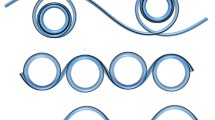Abstract
We explore the effects of two typical torques on the mechanical property of the helical configuration for an intrinsically straight filament or biopolymer either in three-dimensional space or on a cylinder. One torque is parallel to the direction of a uniaxial applied force, and is coupled to the cross section of the filament. We obtain some algebraic equations for the helical configuration and find that the boundary conditions are crucial. In three-dimensional space, we show that the extension is always a monotonic function of the applied force. On the other hand, for a filament confined on a cylinder, the twisting rigidity and torque coupled to the cross section are irrelevant in forming a helix if the filament is isotropic and under free boundary condition. However, the twisting rigidity and the torque coupled to the cross section become crucial when the Euler angle at two ends of the filament are fixed. Particularly, the extension of a helix can subject to a first-order transition so that in such a condition a biopolymer can act as a switch or sensor in some biological processes. We also present several phase diagrams to provide the conditions to form a helix.








Similar content being viewed by others
References
Allard JF, Rutenberg AD (2009) Pulling helices inside bacteria: imperfect helices and rings. Phys Rev Lett 102:158105
Andrews SS, Arkin AP (2007) A mechanical explanation for cytoskeletal rings and helices in bacteria. Biophys J 93:1872–1884
Benham CJ (1977) Elastic model of supercoiling. Proc Natl Acad Sci USA 74:2397–2401
Benham CJ (1989) Onset of writhing in circular elastic polymers. Phys Rev A 39:2582
Bustamante C, Marko JF, Siggia ED, Smith S (1994) Entropic elasticity of lambda-phage DNA. Science 265:1599–1600
Carballido-López R (2006) The bacterial actin-like cytoskeleton. Microbiol Mol Biol Rev 70:888–909
Chouaieb N, Goriely A, Maddocks JH (2006) Helices. Proc Natl Acad Sci USA 103:9398–9403
Daniel RA, Errington J (2003) Control of cell morphogenesis in bacteria: two distinct ways to make a rod-shaped cell. Cell 113:767–776
Erickson HP, Taylor DW, Taylor KA, Bramhill D (1996) Bacterial cell division protein FtsZ assembles into protofilament sheets and minirings, structural homologs of tubulin polymers. Proc Natl Acad Sci USA 93:519
Esue O, Wirtz D, Tseng Y (2006) GTPase activity, structure, and mechanical properties of filaments assembled from bacterial cytoskeleton protein MreB. J Bacteriol 188:968–976
Fain B, Rudnick J (1999) Conformations of closed DNA. Phys Rev E 60:7239
Fain B, Rudnick J, Östlund S (1997) Conformations of linear DNA. Phys Rev E 55:7364
Gitai Z, Dye N, Shapiro L (2004) An actin-like gene can determine cell polarity in bacteria. Proc Natl Acad Sci USA 101:8643–8648
Gitai Z, Dye N, Reisenauer A, Wachi M, Shapiro L (2005) MreB actin-mediated segregation of a specific region of a bacterial chromosome. Cell 120:329–341
Goldstein H (2002) Classical mechanics, 3rd edn. Addison-Wesley, Boston
Goriely A, Shipman P (2000) Dynamics of helical strips. Phys Rev E 6:4508
Iwai N, Nagai K, Wachi M (2002) Novel S-benzylisothiourea compound that induces spherical cells in Escherichia coli probably by acting on a rod-shape-determining protein(s) other than penicillin-binding protein 2. Biosci Biotechnol Biochem 66:2658–2662
Jones LJF, Carballido-López R, Errington J (2001) Control of cell shape in bacteria: helical, actin-like filaments in Bacillus subtilis. Cell 104:913–922
Jung Y, Ha BY (2019) Confinement induces helical organization of chromosome-like polymers. Sci Rep 9:869
Kessler DA, Rabin Y (2003) Stretching instability of helical springs. Phys Rev Lett 90:024301
Kratky O, Porod G (1949) Rontgenuntersuchung gelöster Fadenmoleküle. Recl Trav Chim Pays-Bas 68:1106
Kruse T, Bork-Jensen J, Gerdes K (2005) The morphogenetic MreBCD proteins of Escherichia coli form an essential membrane-bound complex. Mol Microbiol 55:78–89
Love AEH (1944) A treatise on the mathematical theory of elasticity. Dover, New York
Marko JF, Siggia ED (1994) Fluctuations and supercoiling of DNA. Science 265:506–508
Marko JF, Siggia ED (1998) Stretching DNA. Macromolecules 28:8759–8770
Moukhtar J, Fontaine E, Faivre-Moskalenko C, Arnéodo A (2007) Probing persistence in DNA curvature properties with atomic force microscopy. Phys Rev Lett 98:178101
Panyukov SV, Rabin Y (2000) Thermal fluctuations of elastic filaments with spontaneous curvature and torsion. Phys Rev Lett 85:2404
Panyukov SV, Rabin Y (2001) Fluctuating elastic rings: statics and dynamics. Phys Rev E 64:011909
Panyukov SV, Rabin Y (2002) On the deformation of fluctuating chiral ribbons. Europhys Lett 57:512–518
Russell JH, Keiler KC (2007) Peptide signals encode protein localization. J Bacteriol 189:7581–7585
Shih Y-L, Le T, Rothfield LI (2003) Division site selection in Escherichia coli involves dynamic redistribution of Min proteins within coiled structures that extend between the two cell poles. Proc Natl Acad Sci USA 100:7865–7870
Smith B, Zastavker YV, Benedek GB (2001) Tension-induced straightening transition of self-assembled helical ribbons. Phys Rev Lett 87:278101
Srinivasan R, Mishra M, Murata-Hori M, Balasubramanian MK (2007) Filament formation of the Escherichia coli actin-related protein, MreB, in fission yeast. Curr Biol 17:266–272
Srinivasan R, Mishra M, Wu L, Yin Z, Balasubramanian MK (2008) The bacterial cell division protein FtsZ assembles into cytoplasmic rings in fission yeast. Genes Dev 22:1741–1746
Starostin EL, van der Heijden GHM (2010) Tension-induced multistability in inextensible helical ribbons. Phys Rev Lett 101:084301
Taghbalout A, Rothfield L (2007) RNaseE and the other constituents of the RNA degradosome are components of the bacterial cytoskeleton. Proc Natl Acad Sci USA 104:1667–1672
Tanaka F, Takahashi H (1985) Elastic theory of supercoiled DNA. J Chem Phys 83:6017
Thanedar S, Margolin W (2004) FtsZ exhibits rapid movement and oscillation waves in helix-like patterns in Escherichia coli. Curr Biol 14:1167–1173
Vaillant C, Audit B, Arnéodo A (2005) Thermodynamics of DNA loops with long-range correlated structural disorder. Phys Rev Lett 95:068101
van der Heijden GHM (2001) The static deformation of a twisted elastic rod constrained to lie on a cylinder. Proc R Soc A 457:695–715
Vats P, Rothfield L (2007) Duplication and segregation of the actin (MreB) cytoskeleton during the prokaryotic cell cycle. Proc Natl Acad Sci USA 104:17795–17800
Zhou Z (2007) Elasticity of two-dimensional filaments with constant spontaneous curvature. Phys Rev E 76:061913
Zhou Z (2018) Novel relationships between some coordinate systems and their effects on mechanics of an intrinsically curved filament. J Phys Commun 2:035008
Zhou Z, Lai P-Y, Joós B (2005) Elasticity and stability of a helical filament. Phys Rev E 71:052801
Zhou Z, Joós B, Lai P-Y, Young Y-S, Jan J-H (2007) Elasticity and stability of a helical filament with spontaneous curvatures and isotropic bending rigidity. Mod. Phys. Lett. B 21:1895
Zhou Z, Lin F-T, Hung C-Y, Wu H-Y, Chen B-H (2014) Curvature induced discontinuous transition for semiflexible biopolymers. J Phys Soc Jpn 83:044802
Zhou Z, Joós B, Wu C-X (2017) Stability of the helical configuration of an intrinsically straight semiflexible biopolymer inside a cylindrical cell. AIP Adv 7:125003
Acknowledgements
This work has been supported by the MOST of China. Funding was provided by National Natural Science Foundation of China (Grant no. 11574256).
Author information
Authors and Affiliations
Corresponding author
Additional information
Publisher's Note
Springer Nature remains neutral with regard to jurisdictional claims in published maps and institutional affiliations.
Appendix: Realization of two applied torques
Appendix: Realization of two applied torques
In this appendix, we show how to realize external torques to obtain Eqs. (6) and (10). Meanwhile, we explain why \(N_zs\) in Eqs. (6) and (10) are in fact different.
Relations between coordinates in different frames
First, note that in general the energy should be defined in a global fixed frame but the Euler angles are defined in local frames. We set the origin of the global fixed frame at \(s=0\), denote the relevant position vector to be \(\mathbf{r}_\mathrm{g}=(x_\mathrm{g}, y_\mathrm{g}, z_\mathrm{g})\) and the locus of the centerline to be \(\mathbf{r}_\mathrm{c}(s)\). The origin of the Euler frame, a local body frame, is at \(\mathbf{r}_\mathrm{c}(s)\). We denote further a position vector in Euler frame as \(\mathbf{r}_\mathrm{E}=(x_\mathrm{E}, y_\mathrm{E}, z_\mathrm{E})\) and define a local ‘fixed’ frame which has the same origin as that of the Euler frame but its three axes have the same orientations as those of the global fixed frame. In other words, ‘fixed’ means to fix the orientations of axes. Consequently, a position vector in the local ‘fixed’ frame is \(\mathbf{r}_f=(x_\mathrm{f}, y_\mathrm{f}, z_\mathrm{f})={\varvec{\lambda }}'\cdot \mathbf{r}_\mathrm{E}\), where \({\varvec{\lambda }}'\) is the transfer matrix of the rotation matrix \({\varvec{\lambda }}\) with (Goldstein 2002)
Clearly, for a general space point \(\mathbf{r}_\mathrm{g}=\mathbf{r}_\mathrm{c}+\mathbf{r}_f\).
A torque along the axis of the filament
Applying a pair of forces \(\mathbf{F}_\mathrm{E}^\pm =(0, \pm F, 0)\) at \(\mathbf{r}_\mathrm{E}^\pm =(\pm l, 0, 0)\), respectively, these forces yield a torque\(=N_3\mathbf{t}_3=2Fl\mathbf{t}_3\) in Euler frame. In global fixed frame, forces become \(\mathbf{F}_{g}^\pm ={\varvec{\lambda }}'(L)\cdot \mathbf{F}_\mathrm{E}^\pm =\pm F(\lambda _{21}(L), \lambda _{22}(L), \lambda _{23}(L))\) and they act at \(\mathbf{r}_\mathrm{g}(L)^\pm =\mathbf{r}_\mathrm{c}(L)+{\varvec{\lambda }}'(L)\cdot (\pm l, 0, 0)=\mathbf{r}_\mathrm{c}(L) \pm l(\lambda _{11}(L), \lambda _{12}(L), \lambda _{13}(L))\). When the filament undergoes a small deformation, the work done by these two forces is
For a finite deformation via a path P, the corresponding energy is therefore
Since the energy is path-independent, we can choose the centerline of the filament as integral path, which leads to
\({\mathcal {E}}_t=-N_3 \omega _3\) is just the last term in Eqs. (6) and (10). It should be not too difficult to realize such a torque. If we fix \(\phi (L)\), it becomes \({\mathcal {E}}_t=-N_3{{\dot{\psi }}}\). Moreover, from rotational symmetry, any torque along \(\mathbf{t}_3\) yields the same energy term.
A torque along the fixed z-axis in 3D space
Now applying a pair of forces \(\mathbf{F}_\mathrm{g}^\pm =\pm F(-\sin \alpha , \cos \alpha , 0)\) at \(\mathbf{r}_\mathrm{g}(L)^\pm =\mathbf{r}_\mathrm{c}(L)\pm l(\cos \alpha , \sin \alpha , 0)\), respectively, \(\alpha \) is an angle around z-axis. It follows that the energy \(\mathrm{d}E_t=-[\mathbf{F}_\mathrm{g}^+\mathrm{d} \mathbf{r}_\mathrm{g}(L)^+ +\mathbf{F}_\mathrm{g}^-\mathrm{d} \mathbf{r}_\mathrm{g}(L)^-]=N_z\mathrm{d}\alpha =2Fl\mathrm{d}\alpha \). Clearly, \(\mathrm{d}\alpha =\mathrm{d}\phi (L)+\cos \theta (L)\mathrm{d}\psi (L)\) since \(\phi (L)\) is also around z-axis but \(\psi (L)\) is around \(\mathbf{t}_3\) and \(\cos \theta \) is the z-component of \(\mathbf{t}_3\). Therefore, \(\mathrm{d}E_t\) gives the third term in Eq. (6). It is also not too difficult to realize such a torque. With a fixed \(\psi (L)\), it becomes \({\mathcal {E}}_t=-N_z{{\dot{\phi }}}\). From rotational symmetry, any torque along z-axis also yields the same term. However, it is very difficult to obtain such a torque from a single force because in this case the energy from \(\mathbf{r}_\mathrm{c}(L)\) becomes very complicate.
A torque along the cylinder axis
The third term in Eq. (10) has been used (Allard and Rutenberg 2009; Zhou et al. 2017) but it lacks a proper explanation on how to realize such a torque and it may be confused with the third term in Eq. (6) so that we clarify this point here.
On a cylinder, we can write \(\mathbf{r}_\mathrm{g}=\mathbf{r}_\perp +z\mathbf{e}_z\), where \(\mathbf{r}_\perp =R (1-\cos \varphi )\mathbf{e}_x - R \sin \varphi \mathbf{e}_y\) and \(\varphi \) is yet unknown. Now we are applying a force F at \(\mathbf{r}_\mathrm{g}(L)\) and let F parallel to \(\mathbf{t}_\perp =\sin \phi \ \mathbf{e}_x-\cos \phi \mathbf{e}_y\) or \(\mathbf{F}=F(\sin \phi \ \mathbf{e}_x-\cos \phi \mathbf{e}_y)\). It follows that \(d\mathbf{r}_\perp =R (\sin \varphi \mathbf{e}_x - \cos \varphi \mathbf{e}_y)\mathrm{d}\varphi \) is also parallel to \(\mathbf{t}_\perp \) so that \(\varphi =\phi \). The work done by this force is \(\mathrm{d}W=\mathbf{F}\cdot \mathrm{d} \mathbf{r}_\mathrm{g}(L)=\mathbf{F}\cdot \mathrm{d} \mathbf{r}_\perp (L)= F R \mathrm{d}\phi \). Therefore, the related energy density is \({\mathcal {E}}_t=-N_z{{\dot{\phi }}}(L)\) with \(N_z=FR\) and it recovers the third term in Eq. (10).
Finally, note that this torque results from a single force so that it should be easier to realize than the \(N_z\) in Eq. (6) since it requires a pair of forces.
Rights and permissions
About this article
Cite this article
Zhou, Z., Wu, CX. Mechanical property of the helical configuration for a twisted intrinsically straight biopolymer. Eur Biophys J 48, 329–340 (2019). https://doi.org/10.1007/s00249-019-01357-4
Received:
Revised:
Accepted:
Published:
Issue Date:
DOI: https://doi.org/10.1007/s00249-019-01357-4




